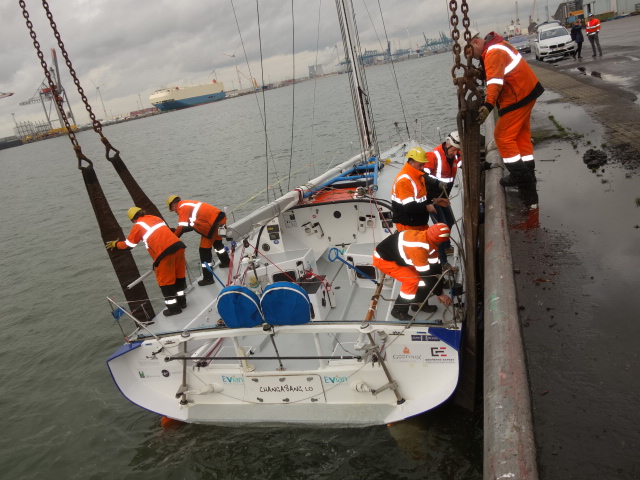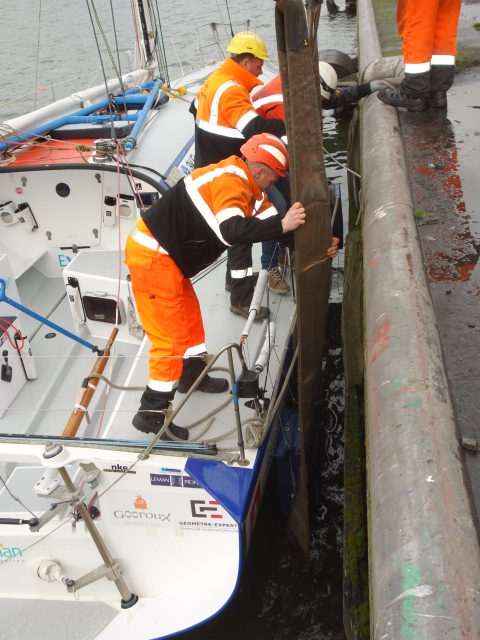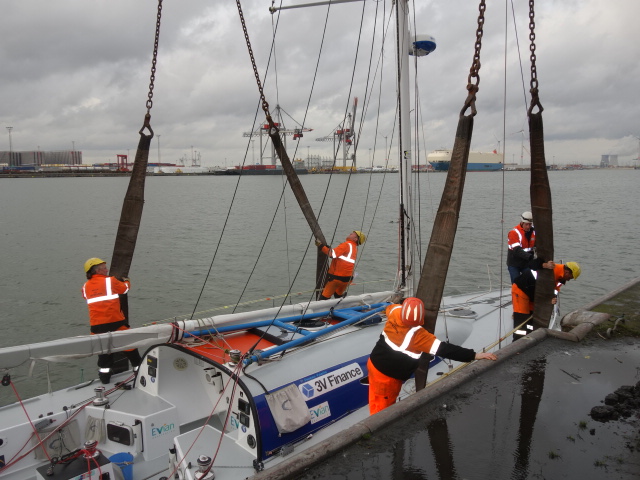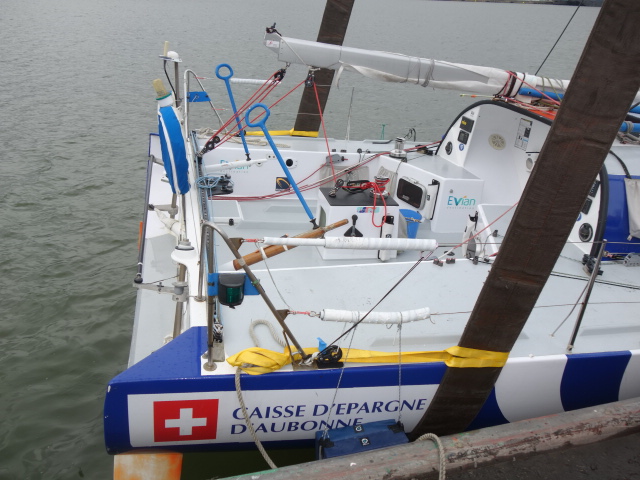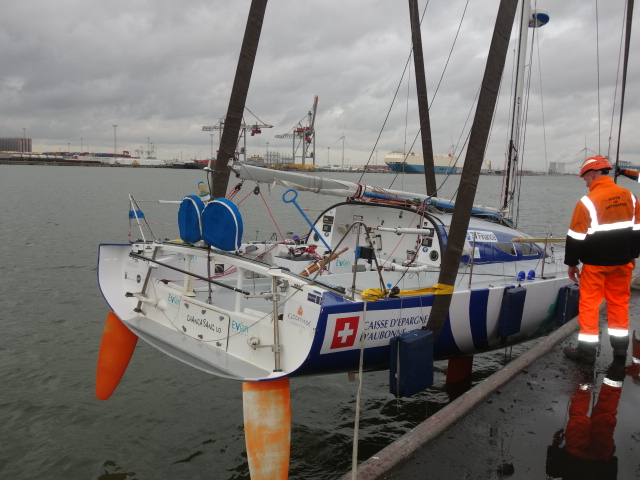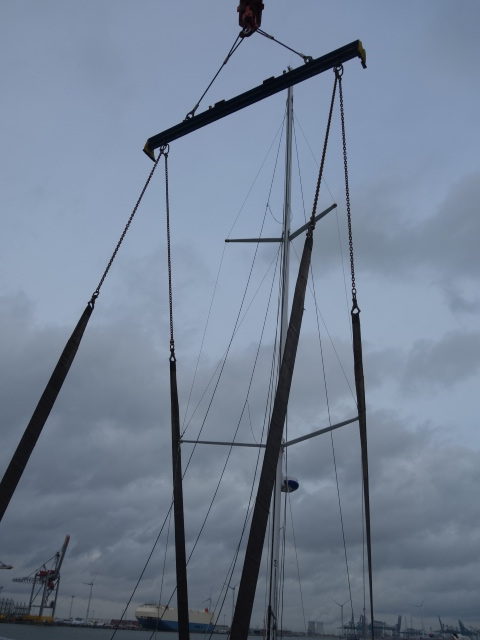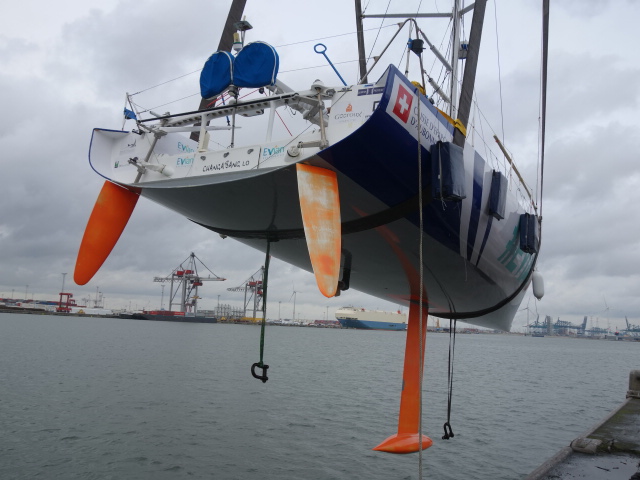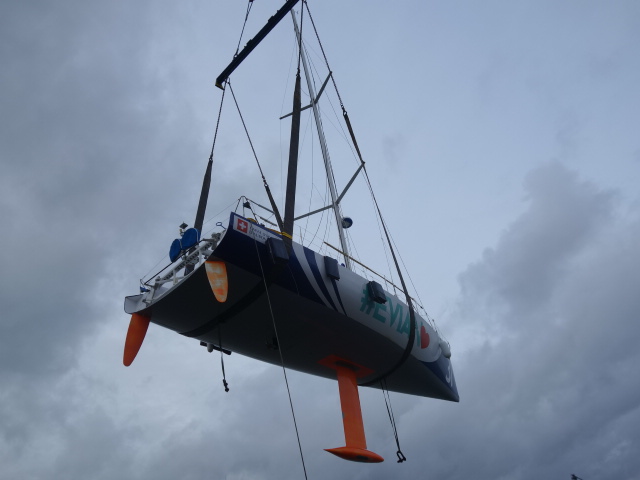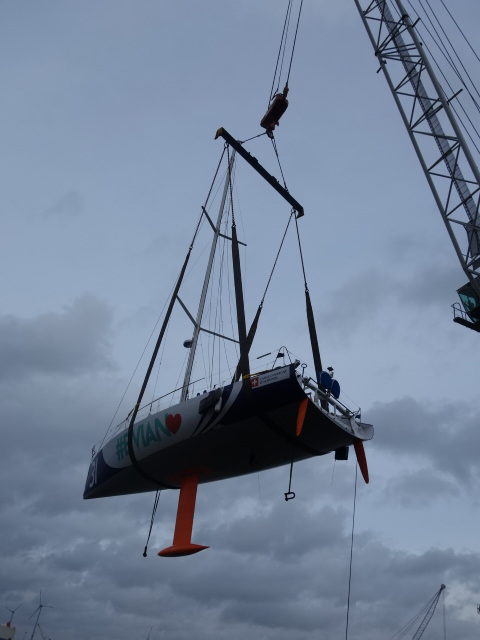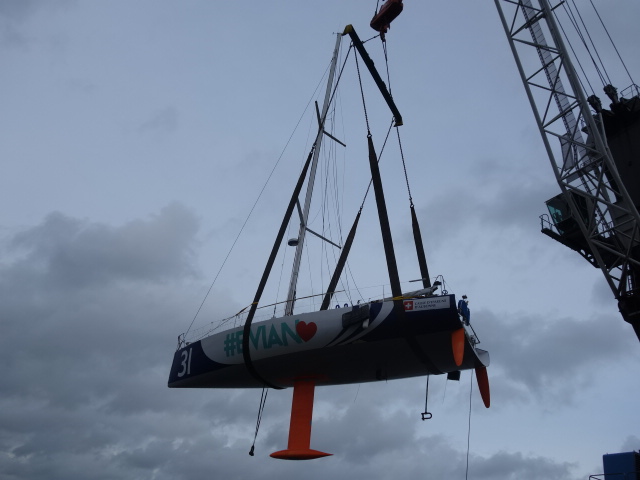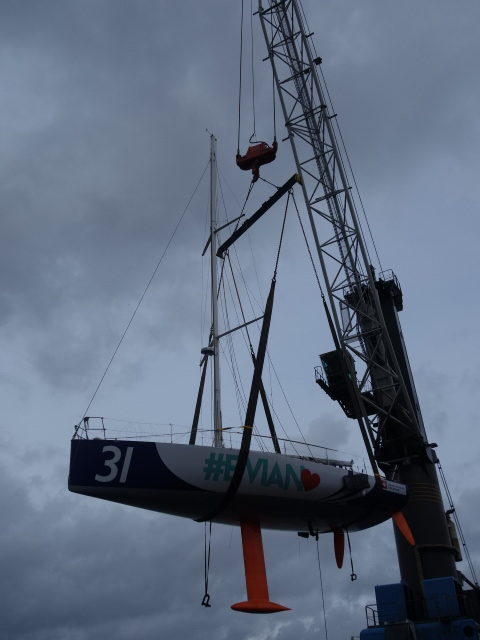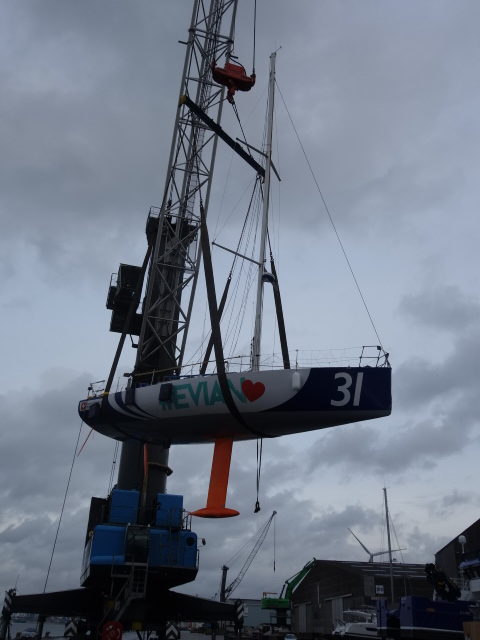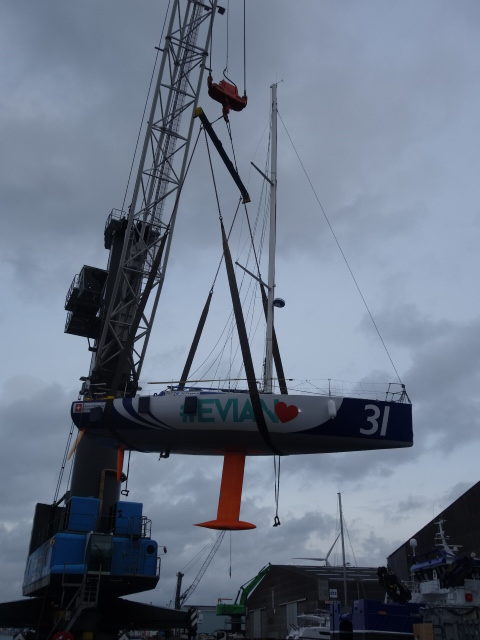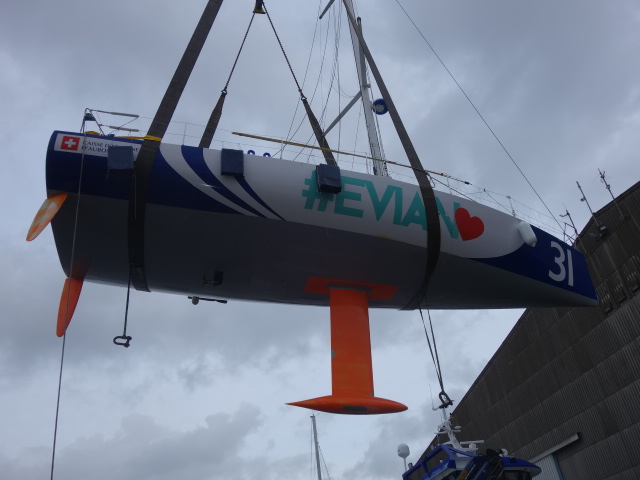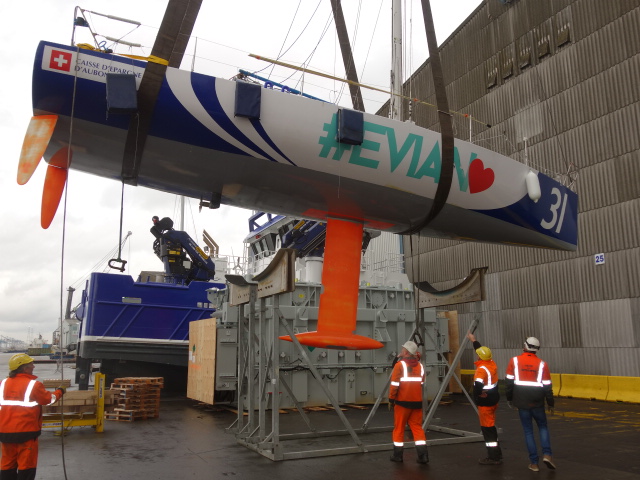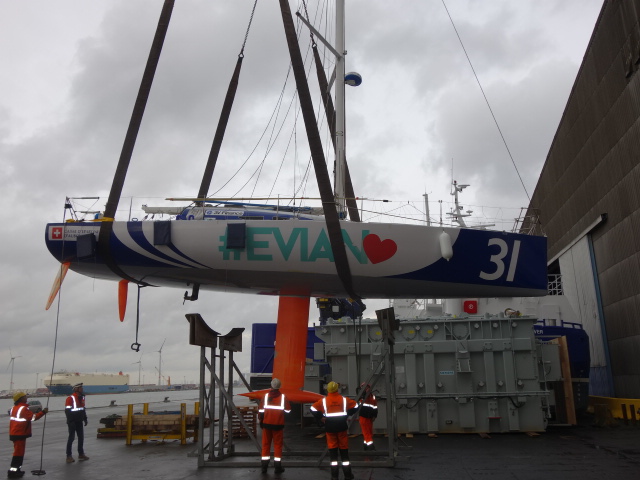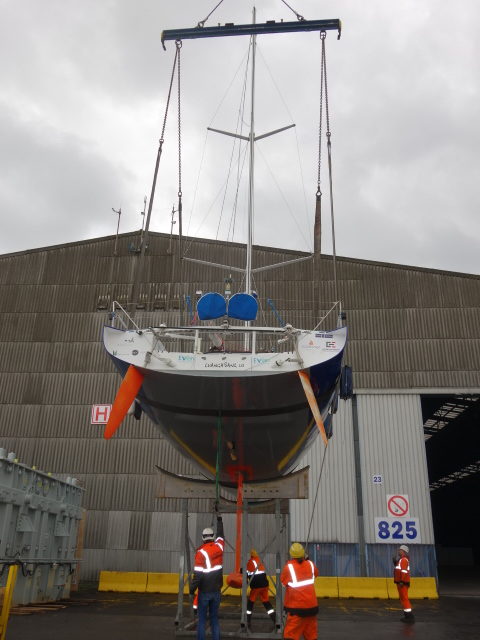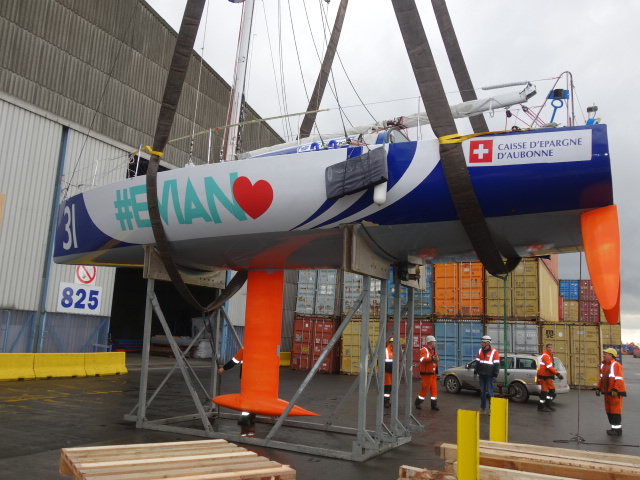Category: Boat purchase
Blog posts related to purchasing a boat fit for a solo non-stop circumnavigation
A fast trip up the US West Coast
On our way from San Diego to Channel Islands Harbor we burned a full tank of diesel. So when we left Channel Islands Harbor we had a full tank and 3 jerry cans loaded with diesel. We needed only half of that to get to Pillar Point Harbor in Half Moon Bay, and some of that was for charging. Once again the usual “if you plan for it you won’t need it” happened, which is a good thing. Other unplanned for events happened too, which were not as good. Read on.

Making plans
We arrived in Channels Islands Harbor Wednesday morning. Lee had family affairs to attend to, and Rob had similar business to cater to. I had the day to myself to tend to small jobs on the boat, and to start thinking about the next leg. My neighbor in the harbor, Ollie, was very friendly and invited me for dinner a couple of times (and to sleep with them as well, but I wanted to start to know Changabang so I slept in my bunk).
The forecast looked good for a departure Friday (as discussed with Robert M.) but I would have to do it alone, which is something I was warming up to but had several concerns about. Faith had it differently as a Facebook post alerted Kathi of my presence on her sailing grounds. Kathi and I go back to our Clipper days. We met up and talked about good old days Thursday evening, then decided to have breakfast together Friday morning. One thing led to another, and she was signed up to sail with Changabang on the trip to her new home, about 285 nautical miles.
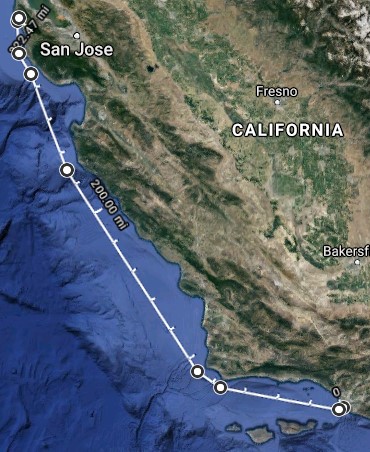
Best sailing ever
After loading gear, food, water and fuel, we motored easily out of the harbor to the oil rig Gina, where we made our first turn for Point Concepcion. Wind was forecast to always be behind the beam and maxing out at 20 kts (with most models showing less than that). This is unusual as most often sailing up North means beating in strong Westerlies/Northerlies.

From there we sailed and motor sailed every time boat speed was dropping below 5 kts. Saturday was a wonderful day with lots of wildlife (dolphins, whales, birds). Wind was variable but most often between 8-13 kts. As evening approached wind started to increase and, after unseamanlike hesitation from the skipper, we dropped to one reef and geared the genoa down to the staysail. Models were still showing good wind behind the beam below 20 kts.
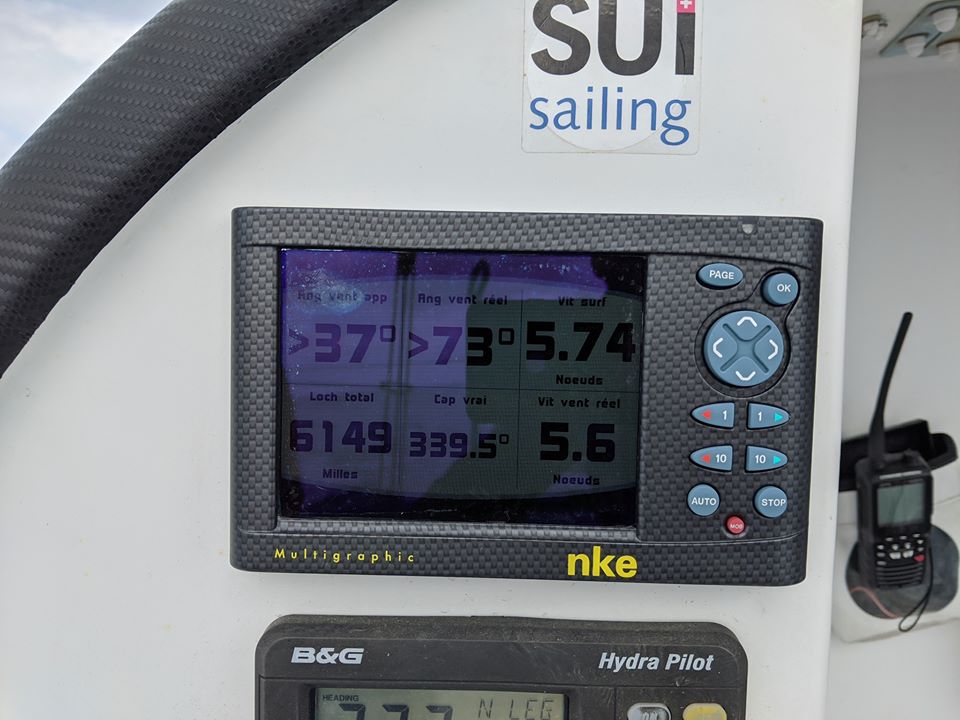
Bang as in Changabang
The night proved all models wrong and it also proved that CaB is a very seaworthy sailboat. Wind started piping up to 20 kts, then 24 kts then fluctuating between 24-28 kts, with gusts above 30 (max I saw was 33). We dropped to the second reef and kept going with boat speed between 8-12 kts, most likely dragging plenty of kelp along. As the wind angle clocked between 120 to 70 of port, Changabang remained mostly flat and was skimming on the big sea. It was amazing how it was; a flying carpet is what I thought of. The old B&G autopilot was handling just fine so Kathi and I remained inside, cozy in our bunks. We experienced the classic videos from the Vendee Globe with water gurgling over the coach roof, as we crossed swell and wind waves. This continued unabated for the night and as we approached Pillar Point we were still seeing 20-25 kts.
Where does trouble happen?
We had had a wonderful and fast ride. Changabang showed she likes offshore sailing. Now it was time to make landfall, and as most sailors know, land can be trouble for boats. We started preparing the boat for landfall, dropping to 3rd reef. We started the engine, pushed it into gear, throttled up and … Nothing happened. The throttle cable was not working. Changabang is not a boat to make landfall under sail in a small craft harbor! Certainly not with a skipper who doesn’t know her well. Her turning radius is very wide too.

From then on it was very much a case of a cascading series of problems, including a few hail calls from a concerned harbor patrol. I fiddled with the cable and got nowhere. I thought to heave to and that caused all sorts of troubles, with the autopilot somehow getting stuck in tack mode. We tried to take the mainsail down (I was hoping that the idle would be enough), only to have top battens entangled in the lazy jack and the running back. Throughout all of that I was picturing Changabang on the beach and funny newspaper articles! I got a little cranky and Kathi took the brunt of it (of which I am not proud). Finally we got things sorted out and were sailing South under staysail alone. I made a call to Skip, whom among other things suggested to jerry rig a line to the throttle lever on the engine.
MacGyver to the rescue
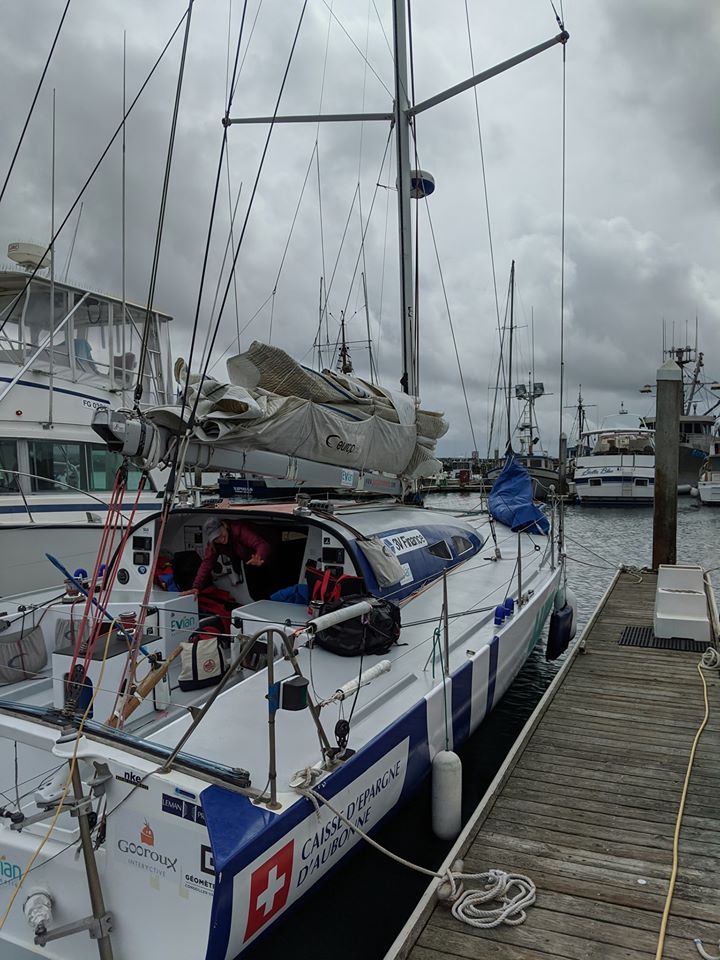
After going through the trouble of jerry rigging that line, we decided to make our approach to Pillar Point. So I get the engine in forward, push the throttle and, oh miracle, it starts working!?!? I’ll skip through the bit of troubles we had docking, only to say that in the end, all is well that is well.
The trip was by far one of my best sailing experiences. It was fun to be along with Kathi; Changabang handled like a dream (with boat speed well below polars; much to learn still); wildlife experiences were everywhere. And best of all it only took us a day and half to get home. Brilliant!
What’s next?
Well, there’s plenty to do. I’ve started emptying the boat to deep clean her. The job list grows; and we have much to add. So keep on following us for future updates, including pictures and funny videos.
Soon in the Pacific?
It looks like MV Star Lima, carrying Changabang, has entered the Caribbean Sea.
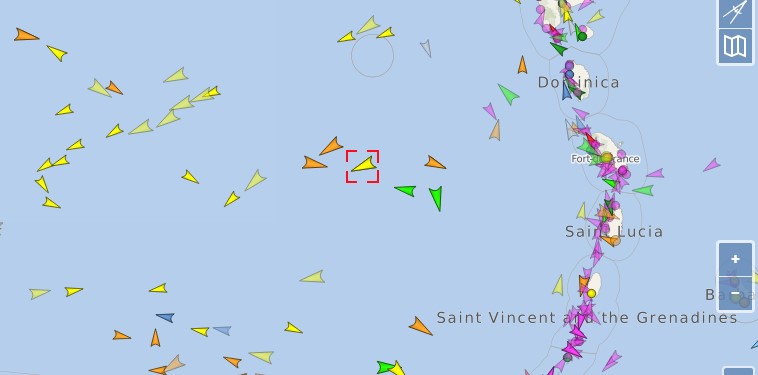
On other fronts, I’ve been busy figuring out my navigation tools so I’ll have an update on that soon. We’ve also received a bunch of samples from our friends at Backpacker’s Pantry so we’ll start eating re-hydrated freeze dried food over the next month; this will allow me to select what will work well for my palate.
And then, keeping an eye on weather, check this out:

There’s only accepting what I’ll get
En route and I was wrong!
It looks like Changabang’s carrier is en route for Cristobal, Panama. I suspect I’ll be checking that AIS web site a little too often!
According to this, I do not need to register with the state of CA if Changabang is a foreign vessel. So I think we’ll go for the Belgian flag after doing the donation to me. Progress!
Loaded!
Changabang was loaded on the cargo ship MV STAR LIMA today. Departure is imminent, or something like that. It looks like she’s not alone; there seems to be a catamaran too.

Obstructions galore
All along this project, every step of the way, things are not smooth. I had planned to get a slip at the Redwood Landing Marina, close to where I live. They had requested liability insurance, which Boat US declined (technically, they declined insurance as they don’t do liability only) but Progressive approved. Now, the management office at the marina is declining the slip because the owner is not a US resident. I’ve learned to sail there, I’ve been an instructor there, for seven years.
On another front I’m trying to understand what procedures I will need to follow when Changabang arrives in San Diego. I’ve tried to reach out to the CBP office of San Diego without success. Nobody answers and I’ve left several voice mails, which are not returned. Apparently, that’s how they operate.
Who owns this boat?
I’m still trying to figure out how to transfer Changabang to me in a way that will be legal. My understanding is that a boat must be documented to a country. I can’t US Document the boat since I’m not a US citizen. Registering the boat in California is not going to work as explained here and there (I did contact the writer of that second article, who confirmed this and indicated a $400/hr fee with a retainer of $3,000 to assist!).
Even with a CA license/title, the boat would not be considered documented as I’m not a US citizen. The boat would then assume my citizenship, i.e. Belgian, and I would require a cruising permit, which is fine. But then Changabang would effectively not be documented with Belgium. Plenty of foreigners do just that (title with CA) and do not realize that they do not have permission to move in the US.
If I document the boat with Belgium, then, on the other hand, California State still requires that I register the boat with them with 120 days of taking ownership, as a US resident. It’s all a nice catch 22 situation.
Cradled again, waiting by the quayside
Thursday morning, a truck showed up in Frossay to pick up Changabang’s cradle. The cradle had to be partly dismounted to meet height and width requirements for road transport.

The cradle arrived in the port of Antwerp on Friday. Another hired skipper and his partner then moved Changabang from the Willemdok marina to the quay where the cargo ship will load her. She was then picked out of the water and dropped back in her cradle. My contact in Antwerp took a bunch of pictures so I grouped them together in the slideshow below. It looks like Changabang still looks great. The next step will be loading and securing her on the cargo ship, which should happen in a few days. The cargo ship is now passing the West corner of Spain.
Unrelated news
As far as updates are concerned I must share that Thursday morning, as part of a large operation at 8×8, Inc, I was laid off (it took 5 minutes at best). I’m still processing that; it’s never fun to feel so disposable. Maybe, I’ll leave in fall 2020 after all. This is exactly what happened the last time I had offshore sailing plans with Clipper and then the Singlehanded Transpacific Yacht Race.
Fabrication
Before Changabang can leave for a circumnavigation there are some key fabrication jobs that I need to consider, primarily adding hydro-generators brackets and an emergency rudder. Yesterday I discussed these jobs with a boatyard in Berkeley. Some of these jobs will take some creative thinking as the stern of Changabang is fairly busy as it is! Ideas and suggestions (based on practical experience) are welcome.

Berthed in Antwerp!
The latest update as of this morning is that Changabang is safely tied in Antwerp. Getting into the marina was delayed yesterday evening due to a lock being out of service. The delivery went really well; they sailed with 3 reefs in the main and one reef in the J1. The keys were transferred to the next skipper who will deliver the boat to the loading dock Friday.
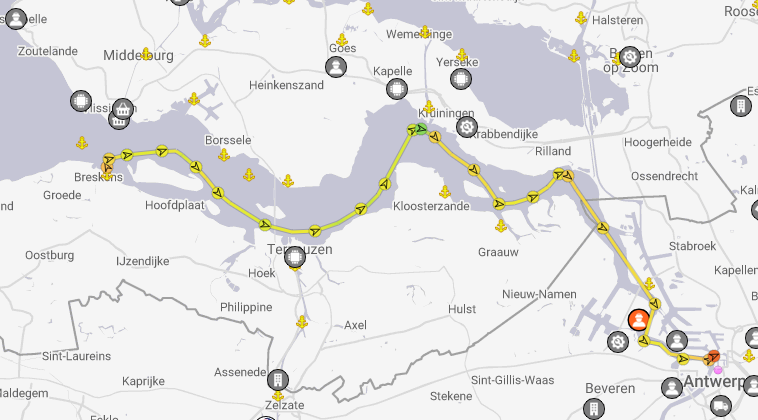
I have received feedback from the delivery skipper about Changabang. So there are some good news: the boat is solid and not slow. And there are some not so good news: the aft ballast scoop is leaking; all on deck plastic needs replacing (sunlight does no good to plastic); the boat will need a serious cleaning inside (moldy) and outside (moldy too); the J1 needs some good maintenance work; some deck hardware needs adjustment. And that’s for the little that the skipper saw during his delivery. I feel like I’m in for a bunch of surprises when I’ll finally get quality time with Changabang.

Things are progressing well. And as usual cost items are showing up where none was expected, and budgeted items are more expensive than anticipated. Hopefully, in a week or so, the boat has been loaded and she’s on her way to her new home. It will soon be time to prepare for the San Diego landing.
En route!
It was not easy but we’re finally on our way to Antwerp. Similarly, the ship, which will carry Changabang to California, is making her way across the Atlantic. Now, the focus is on the transfer in Antwerp. If you know someone nearby Antwerp who could move the boat from the Willemdok marina to the cargo ship, please let me know 🙂

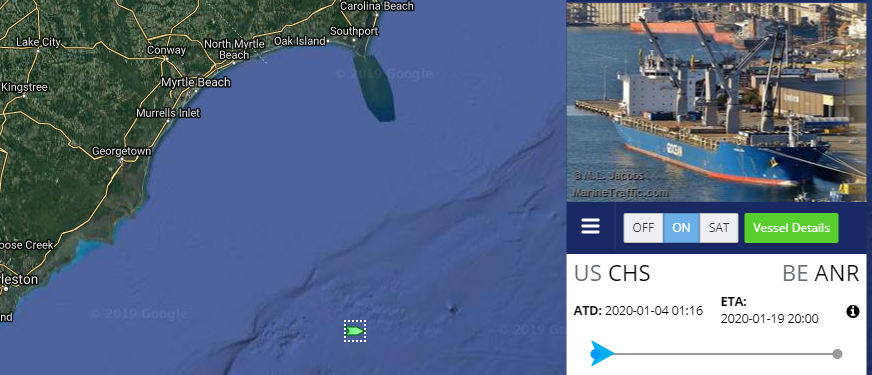
2020 short update
Greetings!
Allow me to start by wishing you all a happy new year, in the hope that we’ll overcome the many hurdles to a healthy Earth and happy societies, with recent news and events making it sound like a tough proposition.

So what’s up with the boat?!?
I’ve had my own share of drama over the past few weeks. I’ve booked the transportation for the boat (yes, I realize it’s time to name her, see below) with Seven Seats Yacht Transport (more on that when the boat is safely in the US). The loading is scheduled for around January 20th. I had a skipper lined up to help deliver the boat from St Nazaire to Antwerp. That plan was thwarted when the delivery skipper on point told me he couldn’t get started until January 8th, which happened only a few days ago. You might think, so what, that’s plenty of days to sail, even motor, the 600 NM to Antwerp?
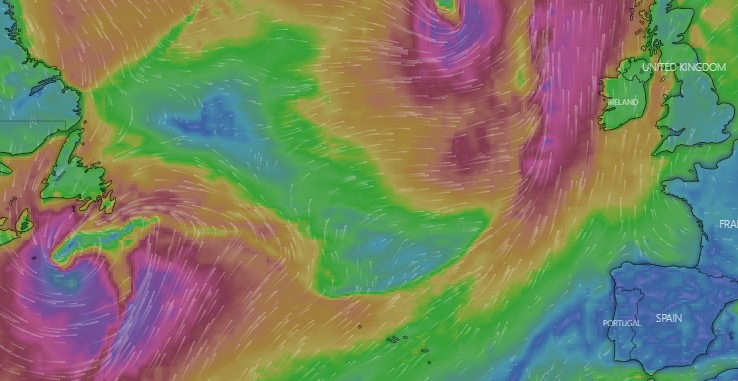
That’s without considering the weather in the Atlantic. It’s winter time and sometimes the French Coast gets hit by consecutive storms, which would making passing the tip of Brittany a very dangerous proposition. So, even though there were 15 days left to sail to Antwerp, I reached out to the few contacts I have in France to identify an alternate delivery skipper. Someone did cautiously step up to the job, at least partially. Now, until yesterday, the weather looked very unpromising. However, to cite one friendly resource in Nantes, during the night of Saturday, things settled big time and a window seems to have magically opened. Oh how lucky! I’ve been a nervous train wreck for the past week!
The potential skipper checked out the boat this morning and liked what he saw. If all goes according to plan, Monday, the boat will leave dry storage for a short stint to Belle-Ile, after a long period of immobilization. Then we will decide what happens next. The new skipper doesn’t want to sail solo for the crossing of the Manche nor make his way alone to the port of Antwerp, a 10 hour long motor stint on the river L’Escaut (The Scheldt). I get it. Check the video below for how this goes in Amsterdam …
What’s in a name?
Maybe it is time to refer to the boat by her name. The previous owner named her Changabang, a mountain in the Garhwal Himalaya of Uttarakhand, India. I’m not sure if there’s a backdrop story to the naming other than the previous owner was/is a climber. Should I change her name? Changabang does seem like a difficult name to spell over VHF or a sat phone conversation …

Closing notes
If we get her on time to Antwerp for shipping to the US, she and her cradle will likely be offloaded in San Diego as there doesn’t seem to be enough cargo (yet) for Stockton. That will be our first sail together then: SD2SF.
I’ve continued to monitor hurricanes (3 more!) and weather along the course. This helps in at least two ways. I get familiar with the weather events in the oceans I plan to cross. And it makes everything more real. I’m becoming intimate with my plans, and that is good. Of course I’m nowhere near to being ready but I’m making progress, at least mentally.
Tomorrow is an important day then!

Money, doubts, weather and updates
This post is going to be the combination of a few things. Hopefully enough to keep you entertained until the end.
Money
Or lack thereof … I’m officially boat poor. Funds have been transferred to the seller and my Euro funds have been wiped. We’re finalizing paperwork and I’m lining up the delivery to Antwerp, shipping company, import agent and other small things. After that, my US funds will be next in line for decapitation. Is it worth it? Yes! I can’t wait for the boat to be here and start preparing. But … read on. Or go here and donate a little to help replenish funds.
Doubts
Of course I’d lie if I wrote that I feel super happy and excited. It’s quite the opposite. There had always been doubts about this undertaking, fears. This particular transition to being a boat owner again crystallized them a little more, which is good as I can now better see what they are, where they stem from.
Nobody and nothing is putting me on this path. It is solely an individual decision. I am not embarking on this adventure to prove anything. It is just something to do and I do love the vision of sailing solo, being immersed in Nature. And, maybe, I want to find myself.
When I hold the thought of this project in my heart, I feel naked, exposed. There is nothing I can lash onto, no obligation, no dependence, none else’s direction. I stand alone. Maybe, that’s what adulthood is about. Making decisions, charting one’s own course, without moral guidance, but one’s own, whether familial, professional, social or religious. Of course, I’m receiving help from folks and that will continue, I hope. I’m not saying that I’m executing this project completely alone. I am saying that when I go up the lighthouse to see who’s shining the light: it is only me up there. Can I be trusted?
Weather

I’ve been keeping an eye on weather, mostly using this and that. My goal was to study the course from San Francisco to Torres Strait. The common way is to go South, pass the Equator somewhere between Samoa and Tahiti, with the hope to avoid doldrums (ITCZ/SPCZ), thunderstorms and light/variable wind areas. But that adds about 800 NM to the Great Circle route. That’s about 4-6 days of sailing. What I am finding is that:
- Leaving from San Francisco may not be as easy as I initially thought. In November there are all sorts possibilities. I could find myself in strong headwinds, no wind or storm conditions. And then sometimes the tradewinds are well established.
- Similarly it is not clear that crossing between Samoa and Tahiti is best. Sometimes the ITCZ appears to duplicate itself. As the picture above shows I could get trapped in light wind and thunderstorms. Things usually change pretty quickly though.
- Forecasts for the Arafura and Timor seas usually show light head winds (3-6 kts). That’s going to make for a long passage! We’re talking about 500 NM at a speed of 3-6 kts or about 5 days.

All that was fine; the big surprise was extreme weather! I knew my course would go through hurricane season in the East Pacific, the South Pacific and the Indian. But I just shrugged it off. Can’t do that! Oh boy, three tropical cyclones have already materialized near my course. There was Rita between Vanuatu and Fiji. And then Ambali; oh gosh Ambali! Explosive intensification they say. Based on JTWC data, Ambali’s winds increased by 185 km/h (115 mph) in 24 hours, marking the fastest 24-hour intensification recorded in the Southern Hemisphere since 1980. Winds topped at 155 mph! It really took less then 48 hours for this thing to develop into a killer. If you were close by there would have been nowhere to run. Add Belna, North of Madagascar, not as explosive, not as strong but larger and longer lived. Ok then … can’t shrug this off. I must continuously monitor extreme weather.
Is there a silver lining? Those 3 hurricanes were NOT on my course.
Other bits
I’ve updated a couple web pages on the web site, here and there.
I came to the realization that, when we will go around Cape Horn for the last third or so of the journey, the boat will likely have about 30,000 NM under her belt and will need to sail another 8,000 more. I’m not a hard core racer so I wasn’t likely to push the boat hard but I will need to sail conservatively if I want to keep the rigging and everything else as fresh as possible. So, I’ll have a boat heavily loaded, sailed conservatively; I wonder how much slower that’ll make us. Time to downgrade our polars!



